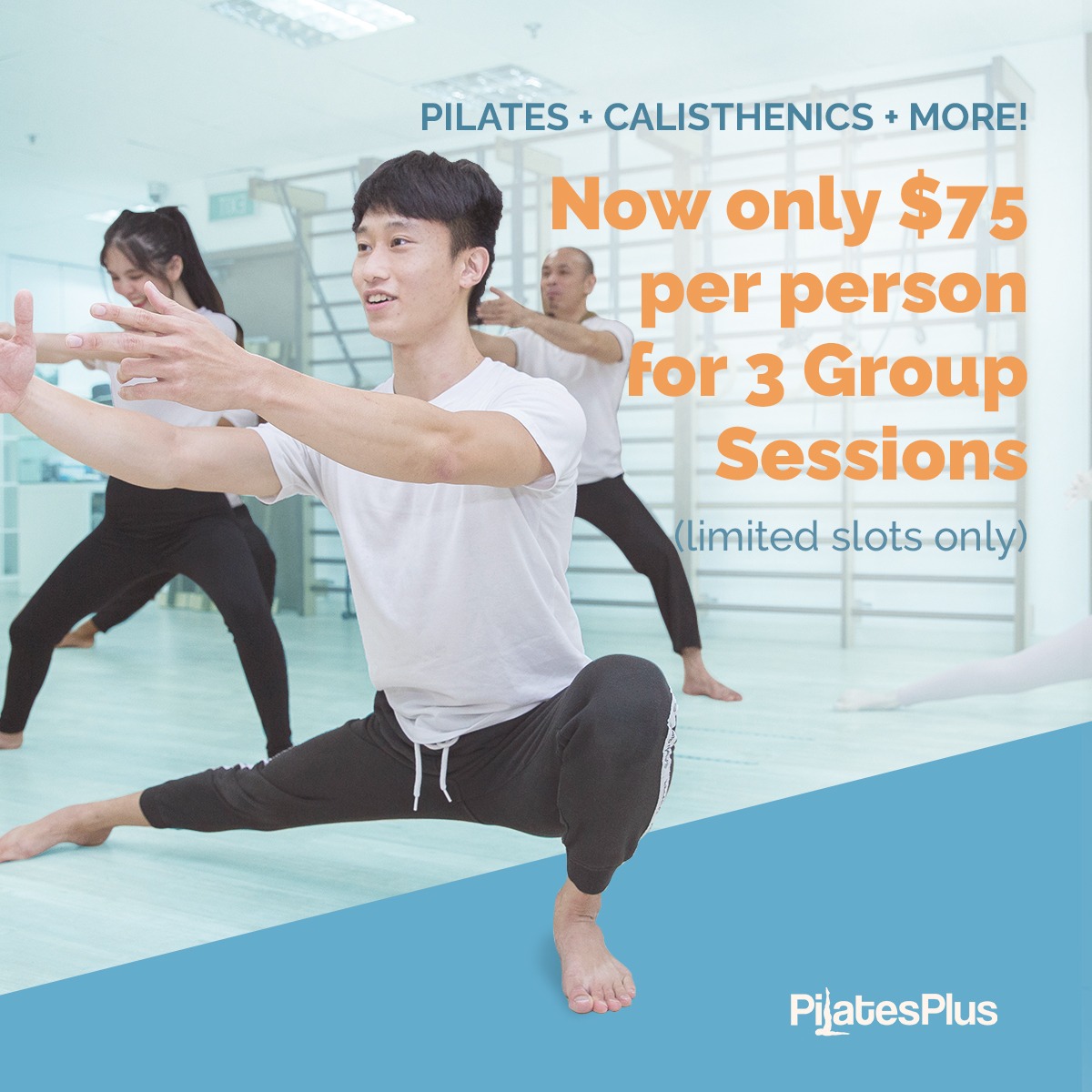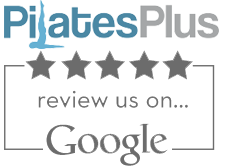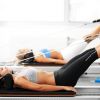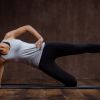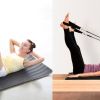PilatesPlus Blog
Home »
What Can You Do on A Pilates Reformer? Positions to Exercise!
Though Pilates exercises can be done on the mat, the Reformer equipment has become a very familiar sight when you think of doing Pilates. Its unique appearance and the interesting movements you can do on it make it very appealing to both first-timers and die-hard Pilates practitioners alike.
There are hundreds of movements that you can do on the Pilates Reformer machine that can target your whole body to do either stretch or strength work. You can lie, sit cross-legged on the carriage, sit on a box, lie face down or up on the box, kneel, or stand to do your exercises on the Pilates Reformer.
First, let us take a closer look at this uniquely designed machine to have a better idea of how it is possible to do so many exercises on this single piece of equipment.

The Pilates Reformer machine has the size slightly smaller than a single bed with a carriage that covers half of its length. The carriage has rollers underneath so it can move horizontally within the frame and is connected with springs to the front end. Most Reformers has 4 or 5 springs that offer different resistance that can be removed to adjust how much tension you want to have on a specific movement.

A pair of straps are connected to the carriage that is looped in a pulley system at the back end of the frame as it goes back to the carriage area. The carriage will move as you pull the straps.

At the front end of the Reformer is a foot bar that can be adjusted in height. The foot bar will serve as an anchor point for you to place your hands or feet to do certain exercises. A common addition to the Reformer machine is the sitting box that can be placed lengthwise or crosswise over the carriage.
If you want to know more about this Pilates equipment, you can read more about the reformer in a separate article here. Now that you have a rough idea of the components of a Pilates Reformer, let me take you through the different possible positions you can be in to do your exercises on it.

Supine exercises on the Reformer
One of the most common ways to start the Reformer exercises is to lie down on your back on the carriage. In this position, you can have the following options:
- Pushing the foot bar to strengthen or stretch your lower body and work on stabilizing your spine at the same time. The foot bar does not move when you push it, but the carriage will move backward instead. This movement is very effective in rehabilitating back injuries. It places the spine in a neutral position while the legs exert effort to push the bar.
- Placing your feet in the loops and moving your legs in different patterns mid-air. One of my favorite exercises on the Pilates Reformer as I can do stretching to open my hips while lying down.
- Holding the loops and pulling them in various directions to do an arm or abdominal workout.

Sitting exercises on the carriage of the Reformer
Another way to position yourself on the Reformer machine is by sitting on the carriage. You can face front, back, or sidewards to do some arm movements while holding the straps. This will challenge your arms, posture, and your core as the carriage moves while you pull the straps.
Alternatively, you can place your hand on the foot bar while sitting on the machine, and you will end up with a different exercise to work on.

Exercises on the sitting box of the Reformer machine
The sitting box is a separate apparatus from the Reformer but it is an integral part of completing your exercise routine. You can place the box lengthwise or crosswise over the carriage in order to use it. It is a simple addition, but it adds many varieties to what you can do on it. Here are some of the common usage of the sitting box:
- Sitting on the box facing front or back to work on your posture and arms by pulling on the straps.
- Prone position on the box to work on your spine extension and arms
- Supine position to challenge your arms and abdominal muscles
- Sitting position sideways to work on your core and spine flexibility

You can be on your knees and workout on the Reformer
Kneeling exercises can be done on the reformer. You can either assume a four-point kneeling where your hands will be supported by the foot bar and your knees on the carriage. You can push the bed with your legs as you work on stabilizing your entire body as the bed moves back and forth. This is a great exercise to work on your core, arms, and legs simultaneously.
Another version is the high kneeling position on the Reformer. You can be facing front, back, or sides, mostly holding the straps with your hands. This position will work your arms and is also very challenging to core muscles, balance, and stability.

Standing to do stretching and strengthening exercises!
An interesting exercise position you can do on the Reformer. You can stand on the carriage while holding the straps, and it will move as you pull the straps. This position can be very unstable and requires a lot of concentration and control. You can do only do this when you reach the advanced level.
Another way of standing on this machine is to have one leg on the front end of the frame, which usually comes with an extended platform and the other leg will be on the carriage. This will allow you to work on your hips to either strengthen or stretch them.
The easiest and most stable standing exercise version is with one leg on the floor and the other leg on the carriage. This is a very stable position that is suitable for beginners to understand how the bed moves in relation to the frame and is very effective in stretching your hips muscles.
These are only the common positions you can do your exercises on the Pilates Reformer. If you are creative enough, you can actually invent new exercises to target movements specific to your sports or daily activities.
The caveat on using the Pilates Reformer, though it offers hundreds of variety of exercises you can work on, you will need a Pilates teacher to guide you. It is not as user-friendly when compared to common exercise equipment you can find in a gym.
Gym vs. Pilates: Which is Better for You? Direct Comparison!
Working out in the gym was the most common way of getting fit 20 years ago until different training methods have arisen in the fitness industry. One of which is the Pilates method which has gained popularity not just to the regular fitness enthusiast but also from people who want to work their posture to high-level athletes who want to improve their performance.
Pilates training offers more advantages than gym training. It works on your strength, flexibility, cardiovascular fitness, and breathing in one session which makes it more efficient compared to going to the gym. The low-impact nature of Pilates training is very suitable for beginners or those recovering from injuries.
I would highly recommend Pilates training to anyone, especially if you are just getting started, but sometimes, it boils down to your personal preference. You may want to sit down and review your goals first before deciding. Below are some items that you may want to consider as I compare both gym and pilates training side by side.
Gym vs. Pilates: Which is more convenient?
If your routine revolves around gym training, regardless if you are an advanced practitioner or a beginner, you will need to go to a gym to do your exercises.
To do a Pilates session, you can choose to go to a big fitness center that offers Pilates classes, to a boutique Pilates studio to attend more specialized Pilates training, or you can do it on your own anywhere.
Winner: Pilates
Pilates training will be a winner for convenience and consistency as you can do it anywhere without depending on any equipment, as long as you have already learned the basic exercises for you to do safely. A good comprehensive YouTube channel that teaches Pilates can guide you with your own training.
How does your session go in the Gym or Pilates?
Exercising in the gym is pretty straightforward; you go in and start your workout. Most likely, you will warm up on the treadmill, lift some weights, do your core training, maybe do more cardio workouts, stretch; then you’re done. This can be done at your own pace, which is quite convenient. You can either finish it in 30 minutes or 2 hours.
In a Pilates class, you will be guided by the teacher all throughout the session. You don’t need to decide which exercise to do next. The session will be from 45 to 60 minutes long. It will consist of an easy warm-up and a full-body routine which includes stretching, strength work, and breathing exercises.
Winner: Tie, depends on your preference
If you want independence in our training, the gym will be good for you. If you prefer guidance the whole time, Pilates classes will be a good option.
Gym vs. Pilates: What type of exercises do you do?
Depending on what your goals are, what machine is available, or your experience in working out, gym training can be very varied. In general, the exercises in the gym can be categorized into five types:
- Cardio workout
- Strength training with weights
- Bodyweight exercise
- Core training
- Flexibility training
Exercises in the gym can either be targeted to specific body parts (isolation training) or a compound exercise that works the whole body or several body parts at one time.
In a Pilates session, to simplify it, you only do Pilates exercises. Though there are several hundreds of Pilates exercises that you can do, most of these exercises are a combination of strength work, flexibility, and breathing. It is very rare to find a Pilates exercise done in isolation to work a certain body part. In addition to this, the Pilates method is focused on doing the movement with precision, so your form and overall body awareness will improve by time.
Winner: Pilates
Pilates exercises are more efficient in terms of time and effectiveness as you are working more than one component at a time. Not only that you are able to work on multiple body parts, but also you are also improving your breathing, flexibility, and strength.
Gym experience vs. Pilates experience
Both Pilates and Gym can have varied experiences depending on where you go, which class you are doing, your fitness level, your preference for training, and the Pilates teacher teaching you.
Winner: Tie – you have to figure this out yourself.

Which is better for flexibility? Gym or Pilates?
If you know how to stretch correctly and still have some time after your cardio workout and weight training, you can improve your flexibility in the gym.
Pilates exercises, by nature, have a built-in flexibility element in them; at any point, you are doing a Pilates movement, you are always somewhat working to be more flexible.
Winner: Pilates
Timewise, it is very efficient to work on your flexibility when doing Pilates exercises.

Gym vs. Pilates for weight loss
The variety of exercises that you can do in the gym and your control of the intensity and duration of your training can be a big factor in your weight loss goal. You can always log in more time on the treadmill to burn more calories or do more reps on exercises that are effective for weight loss.
On the other hand, Pilates will be limited to Pilates exercises that can still be effective for weight loss. The intensity and the variety of the exercises that you can choose from will be dependent on the class you are attending. And it is always limited to an hour per session which will limit the calories you can burn.
Winner: Gym training
Working out in the gym is superior to losing weight compared to just Pilates training only.
Gym vs. Pilates for cardiovascular fitness
In the gym, you can work on your cardiovascular fitness in many ways:
- Working on the treadmill, elliptical trainer, rowing machine, and other types of equipment specific for a cardiovascular workout.
- You can do circuit type training with weights or bodyweight training which is also effective for your aerobic fitness.
In a Pilates class, the exercises are done non-stop, which will challenge your cardiovascular fitness. It can be very effective if the class you are attending is suited to your level, but you’ll be short-changed if you are too advanced for the class.
Winner: Gym training
Gym workouts just offer you more variety and control to work on your cardiovascular fitness, so it is definitely a winner here, but Pilates sessions come close with this one.
Equipment comparison between gym and Pilates
We all know that there is a lot of equipment that we use when working out in the gym. We will name the most popular ones here and what do we use them for.
Treadmill, stationary bikes, stair climber, elliptical trainer, etc. – Machines to work on your cardiovascular fitness.

Dumbbells and barbells for strength training.

Squat racks and multistation strength machines for strength training

Pull-up bars, and dip stations for bodyweight exercises.

The pilates method offers unique equipment only specific to Pilates exercises. You can find these pieces of equipment in a Full Pilates Studio that has experienced Pilates teachers to guide you on how to use these machines.
Pilates mat – Pilates exercises can be done on the floor but it will be more comfortable to do it on the mat. Most prefer a thicker mat of up to 15 mm as it offers more cushion as you move on it. Learning Pilates mat exercises will give you the freedom to do the exercise anywhere. Here is an article I wrote about the benefits of Pilates mat exercises.

Pilates Reformer – one of the most popular Pilates equipment. It has a moving carriage that is attached on the frame by springs and a pair of straps that is connected to the carriage via a pulley on the other end of the frame. You can do a full-body workout on the Pilates reformer.
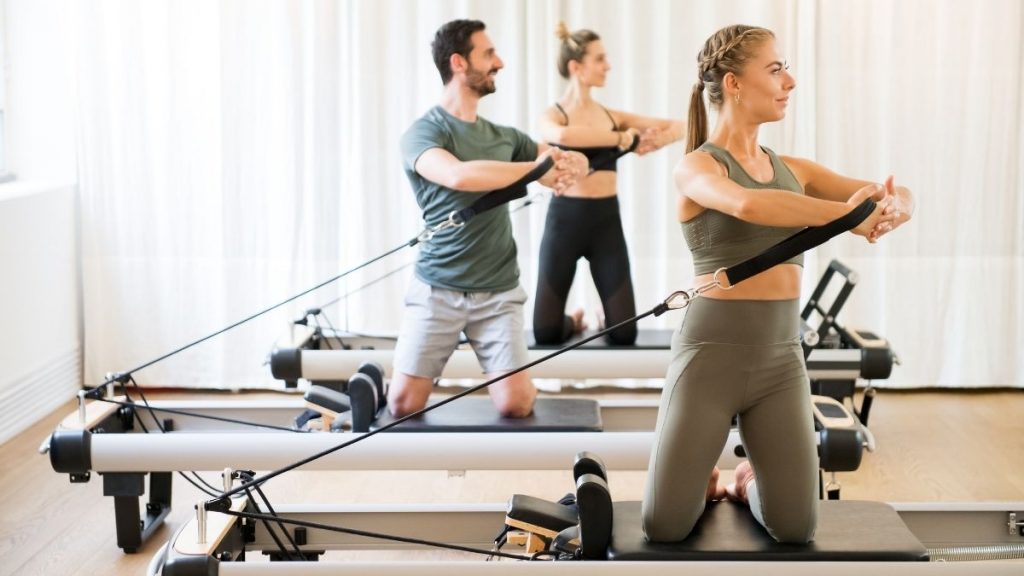
Wunda Chair – is like a chair with pedals attached to it via springs. A full-body workout can be done on this machine but it has a limited variation that works the upper body compared to the Pilates reformer.

High barrel – is a barrel and a ladder combined together. This equipment is perfect for lower body stretches and core training.

Spine corrector – a piece of portable Pilates equipment that is very effective to work on your spine articulation and core exercises.

Cadillac – this equipment can offer you a wide variety of exercises. It resembles a hospital bed with a stainless frame around it. Springs and trapeze can be used to make the exercises easier or harder. The Cadillac is widely used for rehabilitation in Pilates practice.

Winner: No winner here in terms of equipment as it is more of your personal preference. The only drawback for Pilates equipment is you will always need a Pilates instructor for you to use it as it has more complex functions.
What is the difference between gym and Pilates after a workout?
Gym training will most likely give you the typical “pumped up” sensation and maybe some soreness the next day. These sensations can be the gauge of how successful your workout is.
In Pilates, you will generally feel light and tall after the session. You will have that feeling of you have worked out some muscles that were never there before. You can still be sore with your core the next day but not as much as an intense gym workout will do.
Winner: In my opinion, I will give Pilates an edge over this one but gym training comes very close as I sometimes long for that soreness where you know that you have done a good workout the previous day.
Gym vs. Pilates: How will you look after a consistent training?
Gym training will most likely give you a more muscular look. Though this will still depend on your exercise selection.
In Pilates training, getting bulky will not be a possibility. You will look leaner, taller, and just nicely toned as a result.
Winner: I will let you decide on this one. It’s a personal preference.
Gym vs. Pilates: Who should be doing it?
Everyone should be doing either gym or Pilates. The only differentiator here is if you are a real beginner or you have some injuries, Pilates might be a good starting point to do build a good foundation.
Gym vs. Pilates for injuries
It is going to be risky if you are injured and you are doing gym training on your own. You may need the guidance of a personal trainer with rehabilitation experience.
You can attend Pilates classes if your injury is mild, but I would highly recommend taking one-on-one training with a Pilates teacher with rehabilitation experience as this will help you do the exercises properly to prevent any risk of reinjuring yourself.
Winner: Pilates
The precision, breathing, attention to detail, and low-impact nature of the practice make Pilates training more suitable to people with injuries or to those who have already recovered and want to go back to their regular fitness training.
Gym vs. Pilates for Athletic performance
Athletes at a higher level are generally strong with good cardiovascular fitness. And if not, it is part of their training to go to the gym to work on these aspects of their fitness.
So Pilates will be a perfect addition to their training as it will correct imbalances in their body and at the same time, it will increase body awareness which will give them the edge to perform better.
Winner: Gym and Pilates are necessary for an athlete to optimize their performance.
Hope this article helped you make the right decision on which route you want to take.
Pilates for Rounded Shoulders: 7 Exercises You Need to Do!
As our lifestyle has revolved around sitting in front of the computer or browsing on our handphone most of the time, rounding of the shoulders has become a more common postural problem not only with the older population but with the younger group as early as in their teens. Correcting this posture will not only make you look better and taller, but it will also help you avoid aches and tightness in the shoulder and neck area.
Pilates exercises can help you correct rounded shoulders and your overall posture. There are specific Pilates movements designed to stretch the tight areas on your chest and upper back. At the same time, you can do exercises that strengthen your spine and shoulders muscles to align your posture better.
Let us examine deeper what the rounded shoulder is to understand what exercises we can do and how does it help to correct it.
What is a rounded shoulder or hunch upper back posture?
A rounded shoulder posture is a position of the upper body where the upper spine is rounded forward (flexed thoracic spine); at the same time, the shoulder blades are rolled to the front of the torso. Your chest is caved-in in relation to your shoulders and this posture will most likely bring the head forward (Neck hyperextension) in relation to the body resulting in a forward head posture.
According to this article by MedicalNewsToday, these common daily tasks in the list below may contribute to rounded shoulder posture:
- using a smartphone or tablet
- using a computer or laptop
- sitting for long periods
- driving a vehicle
- bending over repeatedly
- carrying heavy objects all-day
Here are the 4 steps on how we will correct the hunch back posture.
1. Stretch the tight muscles rounding your shoulder
One of the main causes of a bad posture is having one area of the body to be overly tight, pulling some parts of the body out of alignment. In this case, it’s the chest muscles that are pulling the shoulders forward causing it to round. Here are 3 stretches we can do to correct this.

- Wall chest stretch
Stand up with your right side facing the wall, with your right foot in front. Place your right hand on the wall with a bent elbow and turn facing away from the wall.
Hold the stretch for 30 to 60 seconds and repeat for the other side. Do the stretch for 2 sets.
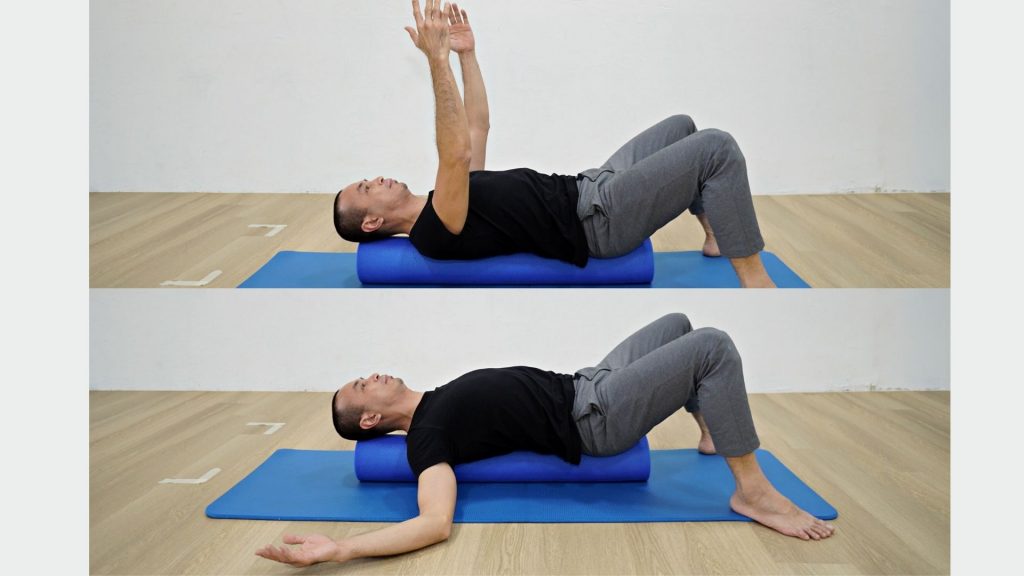
- Foam roller open to W stretch
Lie down lengthwise with your back on a long foam roller. Start with both arms raised to the ceiling with your elbows slightly bent.
Open your arms down to the side, aiming to touch both elbows and hands to the floor,
It’s ok if you can’t touch the floor at first, but just keep aiming for it.
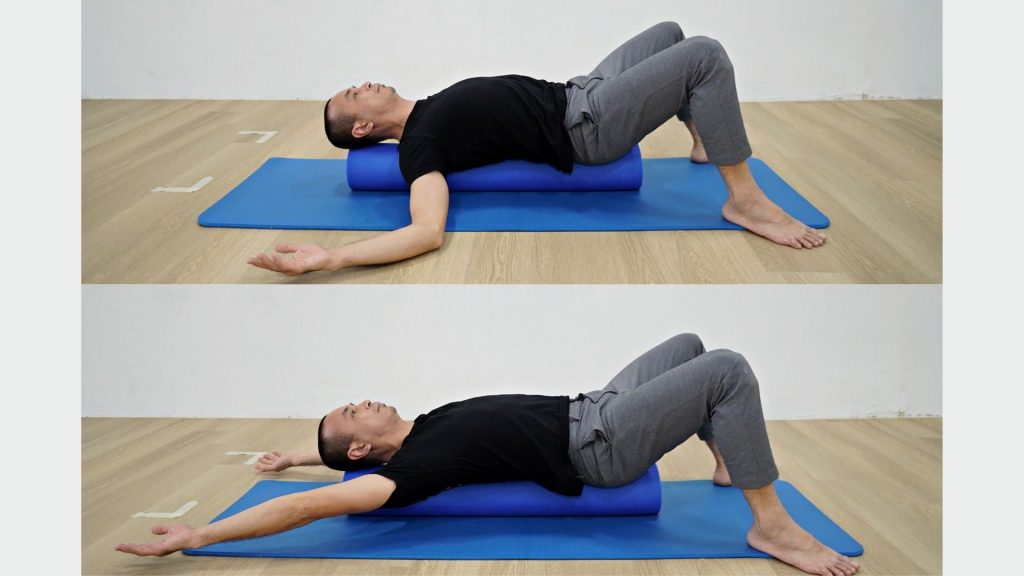
- Foam roller W to Y stretch
This is a continuation of the W-stretch. Once you are at the lowest point of your W-position, gradually bring your arms overhead into a Y-position.
Aim to keep your elbows and hands as close as you can to the floor as you go to the Y position.
A good modification for the W-stretch and the W to Y Stretch is to carry a light object like a 2-lb dumbbell or a water bottle on both sides. Relax and allow the weight to stretch your chest muscles instead of resisting it. Breathe deeply as you are in the stretch position to relax the muscles further. Avoid arching your back when doing these 2 stretches.
Do all of these stretches slowly and find the angle that you find the most resistance and add a pause to that position to deepen the release.
2. Mobilize the thoracic spine into extension
The other biggest factor why our shoulders round is because of the thoracic spine or your upper back. The thoracic spine starts from where your ribs are attached all the way up to around shoulder level. Our thoracic spine is rounded forward in nature; it is part of the natural curvature of our entire spine.
But the problem arises when we are spending too much time sitting at our desks or using our mobile phones. And at the same time, we rarely extend our thoracic spine the other way. This will cause the front part of the spine to get stuck, and we need to open it up regularly to remind the body that it can be opened. Here is a very effective stretch to do just that.
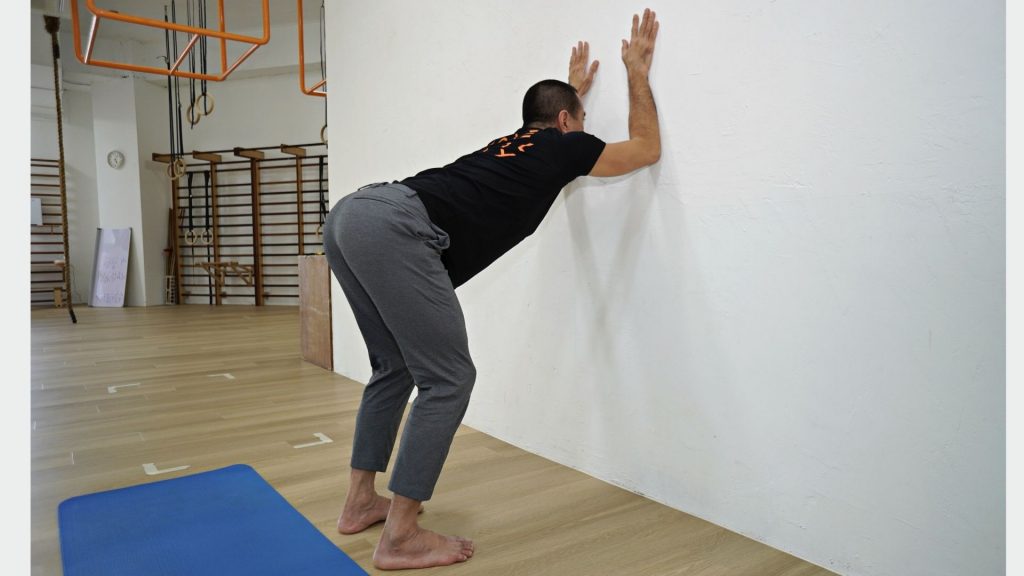
- Thoracic extension stretch on wall
Start standing facing the wall around 1 to 2 feet away from it.
Bend forward and place your forearm on the wall trying to keep it parallel.
Keep your abdominals tight and your lower back flat or rounded if possible so we can isolate the stretch on your upper back.
Now, try to extend your thoracic spine by lifting your chest upwards without moving anything else.
You can go in and out of the stretch to understand it better and hold it for 15 to 30 seconds on the final rep.
This stretch displays a very small movement, yet it is a very effective one when done correctly. Pay attention to the details to learn it properly.
3. Strengthen the weak muscles to open up the shoulders
In order to correct the hunchback posture, stretching the tight muscles will not be enough to correct it. You need to activate and strengthen the opposite muscles that got weakened over time. Here are 2 exercises you can do to strengthen the upper back muscles.

- Prone W retraction and external rotation
Lie facing down on your mat with your arms forming a W-shape.
Lift both arms off the floor, keeping the W position without arching your back.

- Prone W to Y
This is a continuation of the Prone W exercise, where you straighten your arms into a Y shape after you lift it up on a W shape.
Aim on raising the arms higher as you go into the Y position. It will be challenging, especially if you are tight with your shoulders. It will improve over time as you keep stretching your shoulders on the foam roller shoulder stretches.
Prone W and Prone W to Y exercises can go to the lower back if not done well; here are some points to consider to do it correctly:
- Keep your face, chest, and legs down the whole time; it is very tempting to lift them higher at the end range of the movement.
- Engage the abdominal muscles as you lift the arms to the W position.
4. Strengthen the back muscles that extend the thoracic spine
The final part to correct your rounded shoulder posture is to strengthen the muscles that extend your thoracic spine. You will see visible results after doing a good thoracic spine extension stretch but the change will not be permanent unless you pair the stretch with a good strengthening work on your upper back muscles.
Here is a good exercise to target the thoracic extensor muscles.

- Prone thoracic extension
Lie facing down on your mat with your forehead just resting on the back of your hands.
With your abdominals engaged, lift your chest, face, hands, and elbows off the mat.
Keep your neck in line with the spine and focus on lifting your chest off the mat and, at the same time, lifting your elbows higher.
Both legs should stay down the entire time.
Daily routine you can do
Let me put together the exercises into one routine so you can just simply follow it regularly. Remember to pay attention to the details of each exercise, as this will be the key to effectively do them.
As you do all these exercises, it is important to incorporate breathing to benefit fully from the movement. Here is an article I wrote about Pilates breathing so you can understand it better.
Warm-up:
Here is a neck and shoulder warm-up routine that I have on my YouTube channel, which you can just follow along. It is good to do easy, general movements on your shoulders and neck before going on specific corrective exercises.
| Exercise | Reps and sets | |
| A1 | Wall chest stretch | 30 seconds per side for 2 sets |
| B1 | Thoracic extension stretch on the wall | 10 reps and hold for 10 seconds on the last rep |
| B2 | Foam roller open to W stretch | 10 reps |
| B3 | Foam roller W to Y stretch | 10 reps of slow and deep movements |
Repeat B1 to B3 for another round.
| Exercise | Reps and sets | |
| C1 | Prone W | 5 reps and hold 3 seconds at the top every rep |
| C2 | Prone W to Y | 5 reps and hold 3 seconds at the end of the range |
| C3 | Prone thoracic extension | 3 reps and hold 10 seconds every rep |
Repeat C1 to C3 for another round.
Remember that postural correction is a perpetual work that never ends. This corrective routine will help you get started but you will need to really commit to change your posture for good and apply this new alignment into how you move daily. See you in the next post.



